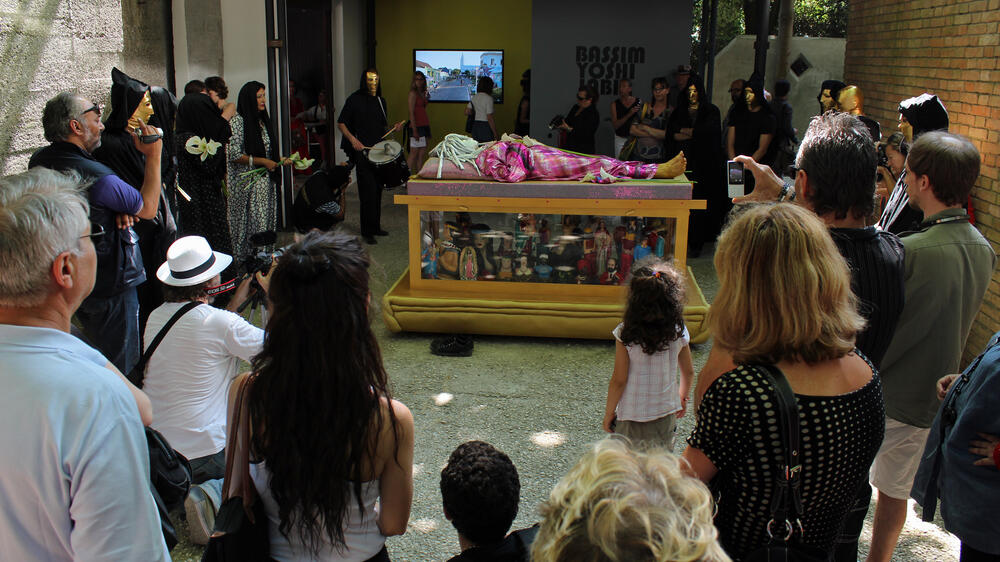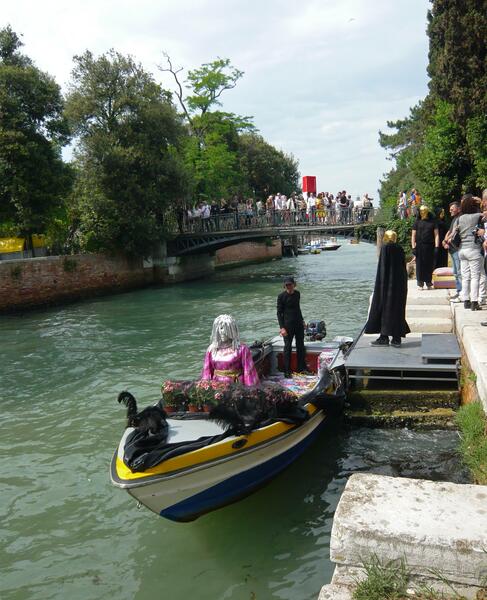Clemencia Labín´s Collective Art Project at the 54th Venice Biennial
Praised by The New York Times
The New York Times refers to Clemencia Labin’s work in the following terms: “The Venezuelan pavilion was invigorated by actual performances by Clemencia Labin and two films about her colourful, creative and inclusive arts festival founded in 2000. A huge success, it has since been held annually in the poor central neighbourhood of Santa Lucía in her home city of Maracaibo, with 44 of the local houses opening their doors as temporary galleries, and dozens of young artists and the community at large taking part”, wrote Roderick Conway Morris.
The New York Time’s article also remarks: “While the arts may be struggling in many parts of the world in the face of reduced resources, the Venice Biennale seems immune to the economic downturn. At the 54th edition, scheduled to continue through Nov 27, there are a record number of national pavilions — 89 in all, including new participants from rich and poor nations, including Saudi Arabia, Andorra, Bangladesh and Haiti — nearly a third more than the total in 1999”.
La Velada Santa Lucía (The Santa Lucia Evening) is a collective project created and organized by Labin that, “promotes socio-cultural acknowledgement of a community that hosts a group of national and international artists, experimenting with an assembly between art and the community.” The Venezuela pavilion also includes two individual projects by Francisco Bassim and Yoshi in the general proposal titled Espacios (Spaces), curated by Luis Hurtado.
The concept of Espacios presents three plastic opportunities of interaction among the piece and art, the spectator and the container. The Velada Santa Lucía’ s webpage mixes the voice of a woman reciting Garcia Lorca’s poem, Llanto por la muerte de Ignacio Sánchez Mejía (Weeping for the death of Ignacio Sánchez Mejía) with a tour by buildings, different artist collective homes whose works can
be seen with a click while their voices are heard.
Gran Interior (Great Interior) by Francisco Bassim is a pictorial piece that questions the frontiers between the artistic and the decorative. Solaris by Yoshi, works on catching the light and its plastic potential from a white paper folded by hand in a proposal that fuses the legacy of oriental art with the masters of Venezuelan abstract geometric art.

Velada Santa Lucía (Fragment about the performance)
By Clemencia Labín
When I think back to my artistic achievements of recent years, I confess that I feel particularly proud of the work I have produced as a collective, my social sculpture titled Velada Santa Lucía. At first sight, this live event might seem different from the rest of my work, most of it three-dimensional bodies of color made with bikini lycra and stuffed with upholstery wadding, as in my Pulpas, for instance. However, a closer look reveals numerous aspects that the Velada has in common with the rest of my work. It is informed in great measure by personal reflection, with the final result being a direct product of my artistic input. The Velada is not about creating works of art to be sold, but about generating collective creative awareness.
Living picture of the saint… Since early childhood I was always enthralled by a photograph of my grandmother Rosa, which through its sheer height dominated our living room. In regal pose, wearing a crown, hair cascading down to her waist, sword in hand and dressed in a long, pink silk robe which emphasized her youthful, Amazonian figure. A full-length, purple velvet cloak with golden slippers, embellished with jewels, added the finishing touches to her majestic attire. The background was a sky-blue wall, her face set off by rays of yellow and white, forming a halo of radiant, solar brilliance. With an appearance transcending that of a mere human being, her lofty bearing lent her an almost divine, celestial presence. I clearly remember the proud gleam in her eyes as she replied to my question: “I’m representing Liberty, in the end-of-year tableau vivant for the María Ragio School. To the amazement of the audience, I spent more than half an hour of the ceremony without moving the merest muscle.” Thus it is in her honour that I dress up as a saint and stand motionless, just as my grandmother did all those years ago.
With this, my annual performance in the Velada, not only do I wish to honour the memory of my grandmother who was very important to my career as an artist, but I am also emphasizing one of the basic characteristics of what it is to be Venezuelan: its multiculturalism. Our people are a product of Spanish colonization, together with a potent mix of social, cultural and religious influences. One example of this is the presence in a great number of households of a small area reserved for sacred effigies which not only reflect the religious beliefs of our people but are also an important point of reference in our popular culture. The image of “Las tres potencias”[2] is an expression of our rich racial heritage in Venezuela – a mixed ethnic palette echoed in the colour scale of white, yellow and black.
For me, the Velada is a magical event. Not only has it reconnected me with my country of origin, it has also taught me to work directly with people. This is very different from my usual way of working as an artist, withdrawn in the seclusion of my studio in Hamburg. Thanks to this event I find myself engaged on an international level in a cultural exchange of ideas, impressions and inspiration with a group of enthusiastic artists, and collaborating with an open-minded local community which allows us to “invade” its privacy and everyday environment. Together we create once a year the great social sculpture, called Velada Santa Lucía.
Translated by Nassimah Reynolds, Spain, & Matthew Partridge, Hamburg
[2] “The three powers”, a popular sculpture, often in painted plaster, showing three figures, an indigenous Amerindian, a white woman and a black man.






